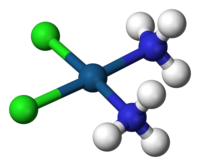
Photo from wikipedia
Abstract Cadmium porphyrin cage compounds Cd1 and 113 Cd1 have been synthesized from the free base porphyrin cage derivative H21 and Cd(OAc)2 ⋅ 2 H2O or 113Cd(OAc)2 ⋅ 2 H2O, respectively. The compounds form… Click to show full abstract
Abstract Cadmium porphyrin cage compounds Cd1 and 113 Cd1 have been synthesized from the free base porphyrin cage derivative H21 and Cd(OAc)2 ⋅ 2 H2O or 113Cd(OAc)2 ⋅ 2 H2O, respectively. The compounds form allosteric complexes with the positively charged guests N,N′‐dimethylimidazolium hexafluorophosphate (DMI) and N,N′‐dimethylviologen dihexafluorophosphate (Me2V), which bind in the cavity of the cage, and tbupy, which coordinates as an axial ligand to the outside of the cage. In the presence of tbupy, the binding of DMI in Cd1 is enhanced by a factor of ∼31, while the presence of DMI or Me2V in the cavity of Cd1 enhances the binding of tbupy by factors of 55 and 85, respectively. The X‐ray structures of the coordination complexes of Cd1 with acetone, acetonitrile, and pyridine, the host‐guest complex of Cd1 with a bound viologen guest, and the ternary allosteric complex of Cd1 with a bound DMI guest and a coordinated tbupy ligand, were solved. These structures revealed relocations of the cadmium center in and out of the porphyrin plane, depending on whether a guest or a ligand is present. 113Cd NMR could be employed as a tool to quantify the binding of guests and ligands to 113 Cd1. 1D EXSY experiments on the ternary allosteric system Cd1‐tbupy‐Me2V revealed that the coordination of tbupy significantly slowed down the dissociation of the Me2V guest. Eyring plots of the dissociation process revealed that this kinetic allosteric effect is entropic in nature.
Journal Title: European Journal of Organic Chemistry
Year Published: 2022
Link to full text (if available)
Share on Social Media: Sign Up to like & get
recommendations!